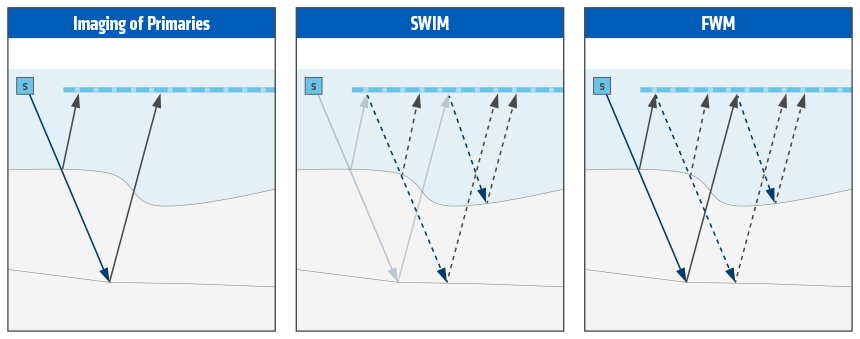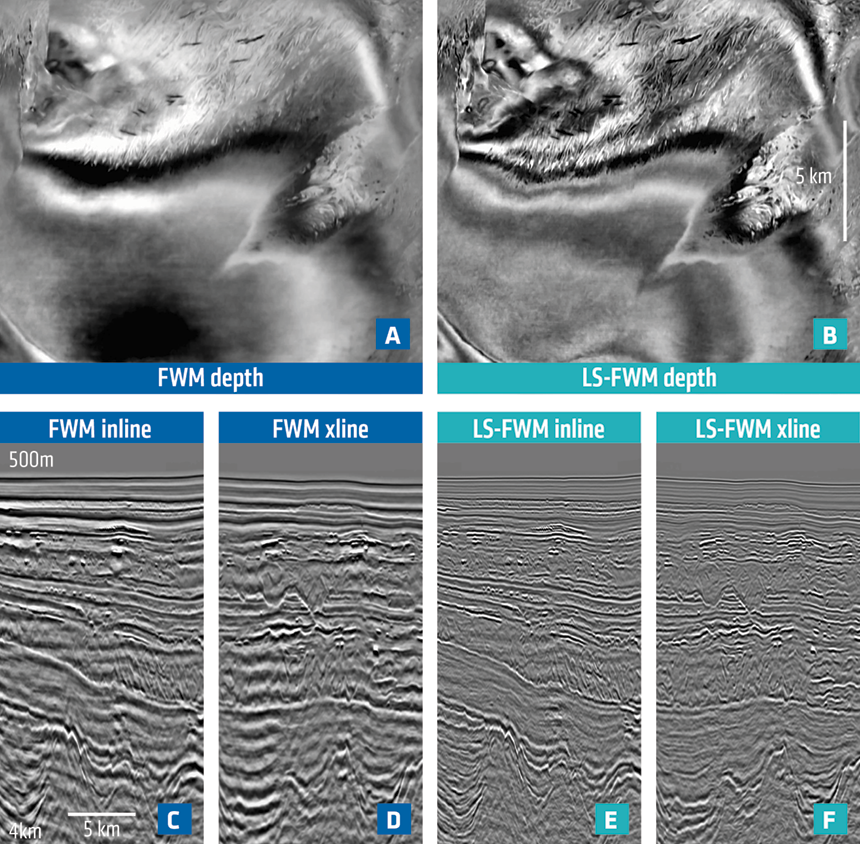Depth migration of the full reflected wavefield, including primary and sea-surface reflected energy (also referred to as free surface multiples or high order reflections), can significantly enhance image illumination and resolution compared to conventional migration. Shaoping Lu, Faqi Liu, Nizar Chemingui, Alejandro Valenciano and Andrew Long outline how least-squares full wavefield migration (LS-FWM) directly computes earth reflectivity by iteratively solving the inversion problem.
 Imaging with primaries. Separated Wavefield Imaging (SWIM) uses only sea-surface reflections and FWM uses both primary energy and sea-surface reflections.
Imaging with primaries. Separated Wavefield Imaging (SWIM) uses only sea-surface reflections and FWM uses both primary energy and sea-surface reflections.
Conventional migration of primary reflections often yields insufficient imaging illumination and resolution and this can be due to limitations in both acquisition geometry and the processing technology employed. Separated Wavefield Imaging (SWIM) uses the downgoing pressure wavefield to exploit the extended illumination provided by sea-surface reflections. Full Wavefield Migration (FWM) jointly images both primary and sea-surface reflected energy but crosstalk and the balancing of the contribution of each component (primary imaging and SWIM) are issues.
In contrast to the limitations noted above, the LS-FWM solution directly computes the earth reflectivity, balances the contributions of primary and sea-surface reflected energy and produces an image that is free of crosstalk interference noise.
Successful applications to both synthetic and field data from the Gulf of Mexico and the North Sea demonstrate that LS-FWM greatly improves the imaging illumination, mitigates the acquisition footprint and reduces cross talk.
In the example below from a WAZ survey from the Gulf of Mexico, considerable improvements can be seen by comparing FWM images with LS-FWM images. The main benefits are less crosstalk and better illumination and resolution. The image improvements include a reduction of the acquisition footprint, higher temporal and spatial resolution and improved wavenumber content. Fault structures are better resolved and amplitudes are more balanced throughout the section.
 FWM versus LS-FWM with 3D WAZ data from the Gulf of Mexico. (A) FWM, depth 1150 m, (B) LS-FWM, depth 1150 m, (C) FWM inline, (D) FWM xline, (E) LS-FWM inline, (F) LS-FWM xline.
FWM versus LS-FWM with 3D WAZ data from the Gulf of Mexico. (A) FWM, depth 1150 m, (B) LS-FWM, depth 1150 m, (C) FWM inline, (D) FWM xline, (E) LS-FWM inline, (F) LS-FWM xline.
Contact a PGS expert
If you have a question related to our Imaging & Characterization services or would like to request a quotation, please get in touch.